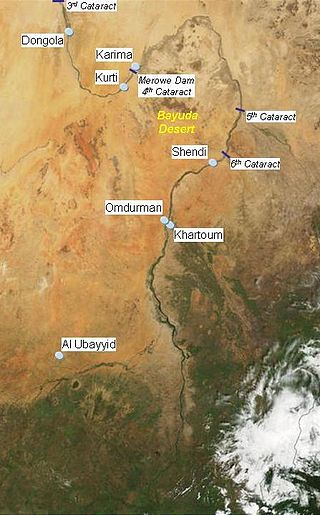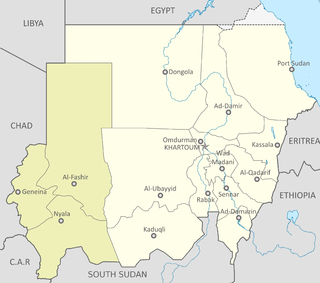
Sudan, officially the Republic of the Sudan, is a country in Northeast Africa. It borders the Central African Republic to the southwest, Chad to the west, Libya to the northwest, Egypt to the north, the Red Sea to the east, Eritrea and Ethiopia to the southeast, and South Sudan to the south. Sudan has a population of 50 million people as of 2024 and occupies 1,886,068 square kilometres, making it Africa's third-largest country by area and the third-largest by area in the Arab League. It was the largest country by area in Africa and the Arab League until the secession of South Sudan in 2011; since then both titles have been held by Algeria. Sudan's capital and most populous city is Khartoum.

The history of Sudan refers to the territory that today makes up Republic of the Sudan and the state of South Sudan, which became independent in 2011. The territory of Sudan is geographically part of a larger African region, also known by the term "Sudan". The term is derived from Arabic: بلاد السودان bilād as-sūdān, or "land of the black people", and has sometimes been used more widely referring to the Sahel belt of West and Central Africa.

Muhammad Ahmad bin Abdullah bin Fahal was a Sudanese religious and political leader. In 1881, he claimed to be the Mahdi, and led a war against Egyptian rule in Sudan which culminated in a remarkable victory over them in the Siege of Khartoum. He created a vast Islamic state extending from the Red Sea to Central Africa, and founded a movement that remained influential in Sudan a century later.

The Funj Sultanate, also known as Funjistan, Sultanate of Sennar or Blue Sultanate, was a monarchy in what is now Sudan, northwestern Eritrea and western Ethiopia. Founded in 1504 by the Funj people, it quickly converted to Islam, although this conversion was only nominal. Until a more orthodox form of Islam took hold in the 18th century, the state remained an "African empire with a Muslim façade". It reached its peak in the late 17th century, but declined and eventually fell apart in the 18th and 19th centuries. In 1821, the last sultan, greatly reduced in power, surrendered to the Ottoman Egyptian invasion without a fight.

Alodia, also known as Alwa, was a medieval kingdom in what is now central and southern Sudan. Its capital was the city of Soba, located near modern-day Khartoum at the confluence of the Blue and White Nile rivers.
Bādī II Abū Daqn, known as The Bearded, was a ruler of the Kingdom of Sennar. He was the son of Rabat I and ascended to the throne in 1644/5.

The Islamization of the Sudan region (Sahel) encompasses a prolonged period of religious conversion, through military conquest and trade relations, spanning the 8th to 16th centuries.

The Shaigiya, Shaiqiya, Shawayga or Shaykia are an Arabized Nubian tribe. They are part of the Sudanese Arabs and are also one of the three prominent Sudanese Arabs tribes in North Sudan, along with the Ja'alin and Danagla. The tribe inhabits the region of Dar al-Shayqiya, which stretches along the banks of the Nile River from Korti to the end of 4th Nile cataract and includes their tribal capital of Merowe Sheriq and parts of the Bayuda desert.

Throughout its history, Darfur has been the home to several cultures and kingdoms, such as the Daju and Tunjur kingdoms. The recorded history of Darfur begins in the seventeenth century, with the foundation of the Fur Sultanate by the Keira dynasty. The Sultanate of Darfur was initially destroyed in 1874 by the Khedivate of Egypt. In 1899, the government of Anglo-Egyptian Sudan recognized Ali Dinar as the Sultan of Darfur, in exchange for an annual tribute of 500 pound sterling. This lasted until Darfur was formally annexed in 1916. The region remained underdeveloped through the period of colonial rule and after independence in 1956. The majority of national resources were directed toward the riverine Arabs clustered along the Nile near Khartoum. This pattern of structural inequality and overly underdevelopment resulted in increasing restiveness among Darfuris. The influence of regional geopolitics and war by proxy, coupled with economic hardship and environmental degradation, from soon after independence led to sporadic armed resistance from the mid-1980s. The continued violence culminated in an armed resistance movement around 2003.

The Sultanate of Darfur was a pre-colonial state in present-day Sudan. It existed from 1603 to 24 October 1874, when it fell to the Sudanese warlord Rabih az-Zubayr, and again from 1898 to 1916, when it was occupied by the British and the Egyptians and was integrated into Anglo-Egyptian Sudan. At its peak in the late 18th and early 19th century it stretched all the way from Darfur in the west to Kordofan and the western banks of the White Nile in the east, giving it the size of present-day Nigeria.

The Shilluk Kingdom, dominated by the Shilluk people, was located along the left bank of the White Nile in what is now South Sudan and southern Sudan. Its capital and royal residence were in the town of Fashoda. According to Shilluk folk history and neighboring accounts, the kingdom was founded by Nyikang, who probably lived in the second half of the 15th century. A Nilotic people, the Shilluk managed to establish a centralized kingdom that reached its apogee in the late 18th and early 19th centuries, during the decline of the northern Funj Sultanate. In the 19th century, the Shilluk were affected by military assaults from the Ottoman Empire, resulting in the destruction of the kingdom in the early 1860s. The Shilluk king is currently not an independent political leader, but a traditional chieftain within the governments of South Sudan and Sudan. The current Shilluk king is Reth Kwongo Dak Padiet who ascended to the throne in 1993.
The history of South Sudan comprises the history of the territory of present-day South Sudan and the peoples inhabiting the region.
The Hamaj Regency was a political order in modern-day central Sudan from 1762 to 1821. During this period the ruling family of the Funj Sultanate of Sennar continued to reign, while actual power was exercised by the regents.

The Turco-Egyptian conquest of Sudan was a major military and technical feat. Fewer than 10,000 men set off from Egypt, but, with some local assistance, they were able to penetrate 1,500 km up the Nile River to the frontiers of Ethiopia, giving Egypt an empire as large as Western Europe.
The Tunjur kingdom was a Sahelian precolonial kingdom in Africa between the 15th and early 17th centuries.

The Kingdom of Fazughli was a precolonial state in what is now southeastern Sudan and western Ethiopia. Oral traditions assert its establishment to refugees from the Nubian Kingdom of Alodia, after its capital Soba had fallen to Arabs or the Funj in c. 1500. Centered around the mountainous region of Fazughli on the Blue Nile and serving as a buffer between the Funj sultanate and the Ethiopian empire, the kingdom lasted until its incorporation into the Funj sultanate in 1685.

The kingdom of al-Abwab was a medieval Nubian monarchy in present-day central Sudan. Initially the most northerly province of Alodia, it appeared as an independent kingdom from 1276. Henceforth it was repeatedly recorded by Arabic sources in relation to the wars between its northern neighbour Makuria and the Egyptian Mamluk sultanate, where it generally sided with the latter. In 1367 it is mentioned for the last time, but based on pottery finds it has been suggested that the kingdom continued to exist until the 15th, perhaps even the 16th, century. During the reign of Funj king Amara Dunqas the region is known to have become part of the Funj sultanate.
The Arabic title nāẓir refers to an overseer in a general sense. In Islam, it is the normal term for the administrator of a waqf. The office or territory of a nāẓir is a nazirate.

The Abdallabi are people living in central Sudan who claim descent from Abdallah Jamma’a. They were an important political force between the fifteenth and eighteenth centuries. For a short time the Abdallabi succeeded in establishing an independent state, but they were defeated by the Funj Sultanate in 1504 and thereafter ruled over the Butana as vassals until the Egyptian conquest of 1820.
Mahu Bey Urfali was an Egyptian military officer of Kurdish origin who participated in the Egyptian conquest of Sudan in 1820 and administered parts of the territory beginning in 1822. He served as the province governor of Berber, located north of the junction of the Nile and Atbara Rivers, from 1822 to 1825. In 1825 he was appointed acting commander of the Egyptian Army in the Sudan, and was sent to the junction of the Blue and White Nile at the emerging capital in Khartoum. He ruled for less than a year because he died from smallpox in 1826. His Arabic laqab, or toponymic nickname, "Urfali", suggests that he came from Urfa in what is now southeastern Turkey.